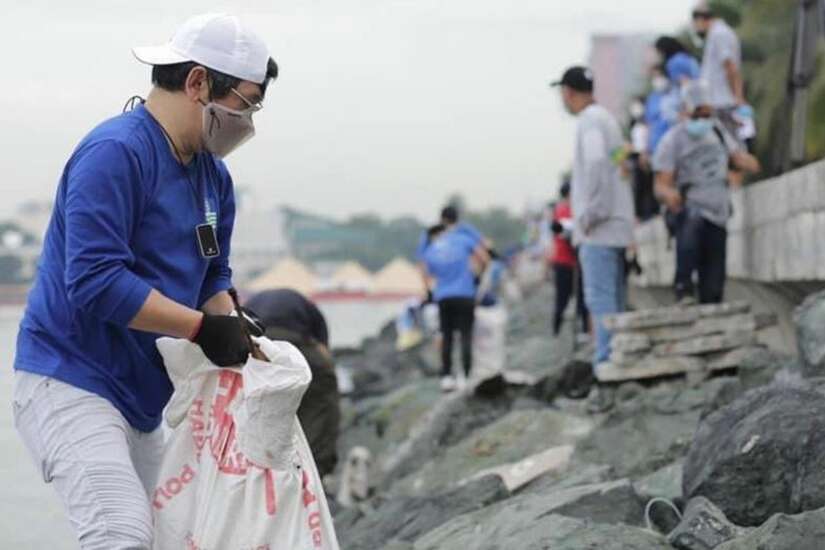Manila Bay white sand project part of generations-saving vision in progress
DOLOMITE is not cancerous nor poisonous.
This, among others, was established in the webinar hosted recently by Manila Bay Coordinating Office (MBCO) Director Jacob Meimban and the Technical Working Group of the estero dredging project.
The webinar was also participated in by engineers from the Metro Manila Development Authority, Department of Public Works and Highways (DPWH), Philippine Coast Guard and private contractors involved in the project.
Also present were the strategic communication and initiatives service officials led by Undersecretary Benny Antiporda and division chiefs.
“Dolomite is not listed among the substances with carcinogen. It has .00 number content of silica which is so small for anybody who might accidentally swallow it to be poisoned,” Antiporda pointed out as he countered claims that the dolomite being used in the Manila Bay white sand project is a health hazard.
The DENR has repeatedly explained that the dolomite being questioned doesn’t pose any risk to life or property.
Citing an explanation from the United States Environmental Protection Agency (USEPA), the DENR noted that any type of dust or inhalable matter (normally 10 micrometers and smaller) can pose as a health hazard because it can be inhaled and go deep into the lung tissues and blood veins.
Any particulate matter bigger than this is not inhalable anymore and poses no threat to health, the DENR added, still citing USEPA.
The department, however, clarified that beach sand and sediments are around 90 micrometers that is why these are not health hazards. The crushed dolomite particles that were placed on the baywalk measure two millimeters to five millimeters, which are 100 times bigger than any beach sand and are impossible to be inhaled, it added.
DENR experts also assured that dolomite doesn’t contain heavy metals and won’t disrupt the coastal ecosystem balance.
“Dolomite is calcium magnesium carbonate. Sea coral itself is calcium carbonate. Therefore, dolomite which has similar composition with that of corals, is not foreign to the coastal ecosystem – it has even a property that lessens the acidity of water- this is the reason why it is widely used in fish aquariums,” DENR experts expounded.
Antiporda also revealed that most if not all of the critics are unaware that the white sand project is just a part of a generations-saving vision in progress.
“Beach nourishment is only a small part of the huge project to rehabilitate the Manila Bay area along the baywalk in Manila. The project also includes dredging in that bay area; dredging of esteros, rivers and waterways that drain into the bay; setting up of trash booms, installation of sewerage treatment plants, construction of septic tanks and improvement of drainage systems, among others,” said Antiporda.
Antiporda also dismissed flak that the DENR project is ill-timed as it is being implemented in the midst of a pandemic.
This, as protesters have been chanting “Kanin di buhangin!” to urge the government to focus its attention on the hungry, the sick and the dying.
“The DENR, DPWH, MMDA, Philippine Coast Guard and other mandamus agencies are not the Department of Health nor the DPWH, which have mandates for these purposes. These agencies have different and specific mandates to fulfill. It is not within the mandate of the DENR to spend its budget on medical, health, food or social welfare purposes. It is mandated to use its resources, whether financial, manpower, or any other type of resources for the protection and conservation of the environment and natural resources even in the midst of a pandemic,” stressed Antiporda.
The DENR official also clarified that the beach nourishment was conceptualized, budgeted and approved by the Department of Budget and Management in 2019, when there was no incident yet of COVID-19 in the country. The memorandum of agreement with the DPWH was signed between October and November 2019, and the DPWH started its implementation in January 2020.
Antiporda also dispelled claims that the rehabilitation effort is overpriced.
“One critic divided the budget to 500 linear meters, which is quite deceiving. The project is estimated to cover 30,000 to 49,000 square kilometers. The P389 million if divided to 500 meters will result to P778,000 per meter, but if it is divided to at least 30,000 square meters, it would result to 12,967 per square kilometer, which is quite reasonable,” he explained.
The DENR undersecretary added that the controversial beach nourishment project is part of a Supreme Court order, a writ of continuing mandamus issued on Dec. 18, 2008 directing 13 government agencies to spearhead the cleanup, rehabilitation and eventual preservation of Manila Bay.
Contrary to protesters’ unfounded fears on the project’s negative impacts, beach nourishment may even boost tourism and commerce as well as rejuvenate the environment, said Antiporda.
According to the DENR official, beach nourishment may even counter the powerful erosional forces of seas and oceans and has become the common practice in many countries like the United States, France and Singapore.
“It was for this reason it was adopted in the rehabilitation of Manila Bay, particularly along the baywalk area in Manila, where coastal flooding often occurs,” said Antiporda.

